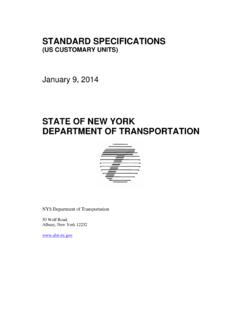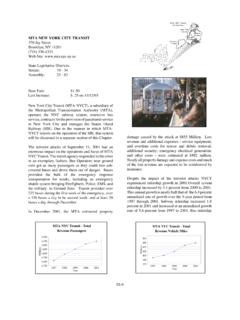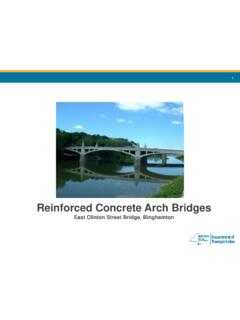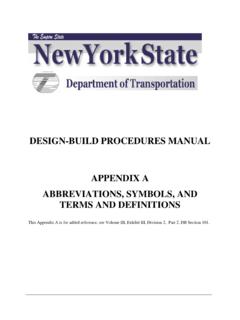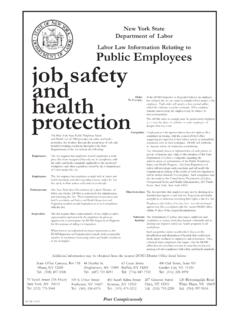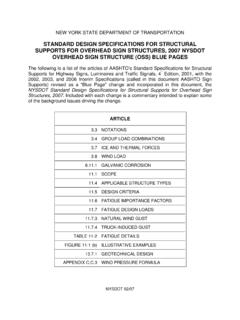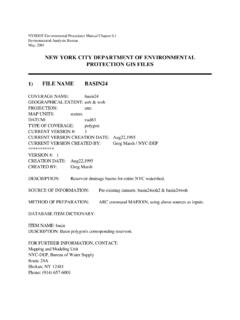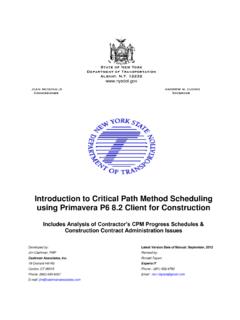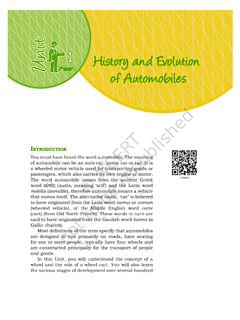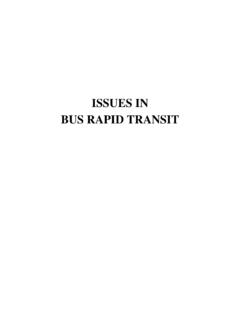Transcription of HIGHWAY DESIGN MANUAL Chapter 10 Roadside Design, …
1 HIGHWAY DESIGN MANUAL Chapter 10 Roadside DESIGN , Guide Rail, and Appurtenances Revision 92 (Limited Revision) March 16, 2020 Issued by Engineering Bulletin 20-018 Effective with DESIGN Approval on or after May 01, 2020 Roadside DESIGN 10-2 EB 20-018 05/01/2020 Section Changes Throughout Updated references to A Policy on Geometric DESIGN of Highways and Streets to the most recent edition (7th edition, 2018) Throughout Chapter reformatted for improved legibility. The new format links the revision to the issuing document and actual effective date, rather than just the issuing date. Throughout Retitled and renumbered tables and figures as consecutive exhibits and updated references in text. Shielding of Pedestrians and Bicyclists Added Bicyclists ; edited and expanded section to include reference to bollards. Security Bollards Inserted new Section Security Bollards Roadside DESIGN 10-3 EB 20-018 05/01/2020 TABLE OF CONTENTS INTRODUCTION.
2 5 NEW, RECONSTRUCTION, AND FREEWAY 2R/3R PROJECTS .. 6 Clear Zones .. 6 Barrier DESIGN Parameters .. 22 Barrier Types .. 46 Median Barriers .. 63 Barrier Terminals .. 86 Impact Attenuators .. 104 Developed Area and Large Volume Exceptions .. 119 EXISTING FACILITIES .. 135 Evaluation of Existing Facilities .. 136 Detailed Scope of Work Determinations .. 145 Documentation of Roadside DESIGN Process for Upgrading of Existing Facilities .. 152 CONSTRUCTION ZONE GUIDANCE .. 156 Temporary Concrete Barriers (TCB) .. 156 Temporary Timber Safety Curb and Median Barriers .. 156 Dragnets .. 156 Moveable Concrete Barriers .. 156 Warrants for Work Zone Barriers .. 156 SPECIAL TOPICS .. 157 Mailboxes .. 157 Fencing .. 159 Cattle Passes .. 165 Guide Posts .. 166 Barriers on Dead-End Roads and Streets .. 166 Public 167 Resetting Guide Rail .. 168 REFERENCES .. 172 APPENDIX A - SPOT EVALUATION OF DESIRABLE CLEAR ZONE WIDTHS.
3 10-A1 APPENDIX B - SUPPORT OF GUIDE RAIL OVER SHALLOW OBSTRUCTIONS ..10-B1 APPENDIX C BARRIER IMPACT TESTING AND ITS RELATION TO IN-SERVICE 10-C1 INDEX .. 10 IND-1 Roadside DESIGN 10-4 EB 20-018 05/01/2020 LIST OF FIGURES Exhibit 10-1 Recommended Basic Recovery Widths (BRW, in feet from travel lane) .. 8 Exhibit 10-2 Horizontal Curve Adjustment Factors (Koc) .. 8 Exhibit 10-3 Clear Zone Segments (Matching Selection to Attainable Clear Area).. 11 Exhibit 10-4 Sample Table of Clear Zone Widths (to be included in Project Plans) .. 13 Exhibit 10-5 Basic Point of Need Determination .. 25 Exhibit 10-6 Crush Accommodation for Parallel-Type Proprietary Terminals .. 26 Exhibit 10-7 Runout Lengths .. 28 Exhibit 10-8 Left Side Runout Lengths .. 29 Exhibit 10-9 Runout Length Alternatives .. 30 Exhibit 10-10 Backslope Anchorage for Weak Post Rail Systems .. 31 Exhibit 10-11 Back Slope Anchorage for Heavy-Post Blocked-Out Corrugated Rail.
4 32 Exhibit 10-12 Clear Area Requirements for Gating 33 Exhibit 10-13 Barrier Deflections for Standard1 Impacts .. 36 Exhibit 10-14 Maximum Lateral Offset .. 37 Exhibit 10-15 Deflection Reduction Factors .. 37 Exhibit 10-16 Intermediate Posts Required to Reduce Rail Deflection .. 38 Exhibit 10-17 Minimum Shoulder Break Offsets (in feet) to Back of Guide Rail Posts .. 56 Exhibit 10-18 Guidance for Median Barrier Use on Non-Interstate High Speed (50 mph or greater) Freeways and Expressways .. 65 Exhibit 10-19 Recommended Barrier Locations for Uneven Medians .. 75 Exhibit 10-20 Single Slope Concrete Median Barrier .. 76 Exhibit 10-21 Moveable Concrete Barrier .. 77 Exhibit 10-22 Truck Barrier (Extra High) .. 78 Exhibit 10-23 Terminals at Crossover Areas .. 84 Exhibit 10-24 Recommended Barrier Flare Rate Limits for Permanent Installations .. 87 Exhibit 10-25 Approved Sand Barrel Array for 90 km/h.
5 109 Exhibit 10-27 Location of HDM Guidance on Roadside DESIGN Process for Existing Facilities .. 136 Exhibit 10-28 Acceptable Barrier Heights When Upgrading Existing Facilities .. 144 Exhibit 10-29 Example Page of Roadside DESIGN 155 Exhibit 10-30 Recommended Guide Rail Installation time Allowances .. 170 Roadside DESIGN 10-5 EB 20-018 05/01/2020 INTRODUCTION INTRODUCTION The purpose of this Chapter is to provide the designer with guidance on measures to reduce the number and/or severity of accidents when vehicles leave the traveled way. The concept of a forgiving Roadside environment was developed in the 1960s. A key element of the concept was the creation of "clear zones" within which a driver might recover control and return to the roadway or at least achieve significant deceleration before striking a fixed object. Where fixed obstacles could not be removed from the clear zone or modified with breakaway features, consideration would be given to shielding them to reduce the severity of vehicle impacts.
6 The American Association of State HIGHWAY and Transportation Officials (AASHTO) incorporated many of these new concepts into the text A Policy on Geometric DESIGN of Highways and Streets (the "Green Book"). A second key publication is AASHTO's Roadside DESIGN Guide which deals more directly with the content of this Chapter . The designer should be familiar with the relevant Roadside DESIGN guidance contained in those publications before developing special-case Roadside designs that deviate from the guidance in this Chapter . Many of New York's state highways were modified or built to meet the early guidance. The guidance gradually evolved to reflect the results of crash test programs and in-service performance of early safety systems. As new facilities were built or major reconstruction projects were undertaken, Roadside features were constructed to meet the DESIGN guidance prevailing at that time .
7 As a result of the ongoing evolution of the guidance, there are many miles of state HIGHWAY which have Roadside features which do not conform or only partially conform to current guidance. One intent of Chapter 10 is to present guidance for new or reconstructed facilities. This guidance is presented under Section New and Reconstructed Facilities. This Chapter also provides guidance for assessing existing facilities to determine the number of safety concerns and nonconforming features that are present in the Roadside area and the amount of upgrading that would be appropriate when work is performed on that existing facility. Roadside safety concerns are defined as features that may (1) increase the severity of a run-off -the-road (ROR) accident, or (2) change a ROR incident into a ROR accident, but are either located beyond the clear zone width or are within acceptable practice.
8 With respect to Roadside DESIGN , nonconforming features are features that do not conform to current practice and are typically within the clear zone width. They may range from mildly deficient to severely deficient. The cost of upgrading some Roadside safety concerns might not be justified if the resulting benefit to public safety is very small. A key factor in judging which features should be upgraded will be the relevant accident history of the facility when compared with other similar facilities. The guidance for performing an accident analysis will be found in Chapter 5 - Basic DESIGN . The guidance for making upgrade judgments is presented under Section , Existing Facilities. Additional guidance for work on existing facilities is presented in Chapter 7 - Resurfacing, Restoration, and Rehabilitation (1R, 2R & 3R). The use of barriers within construction work zones was previously contained in Section Construction Zone Guidance but has been moved to HDM Chapter 16.
9 Additional guidance for treatments of work zones is presented in Chapter 9 of AASHTO's Roadside DESIGN Guide. Section Special Topics discusses additional features that are significant to Roadside DESIGN . Roadside DESIGN 10-6 EB 20-018 05/01/2020 NEW, RECONSTRUCTION, AND FREEWAY 2R/3R PROJECT NEW, RECONSTRUCTION, AND FREEWAY 2R/3R PROJECTS The purpose of this section is to provide guidance for the DESIGN of Roadside features on new construction, reconstruction, freeway Resurfacing, Restoration and Rehabilitation (3R), and freeway 2R projects. Guidelines for evaluation of existing highways are addressed separately in Section Existing Facilities. Identification of safety concerns and nonconforming Roadside features on reconstruction projects should follow the guidance of Section , while the DESIGN to remedy identified problems should follow the guidance of Section The general Roadside DESIGN policy for new, reconstruction, and freeway 2R/3R projects is to provide satisfactory clear zones, whenever it is practical to do so, and appropriately designed barriers, when it is not.
10 Section introduces the clear zone concept and the hierarchy of DESIGN options for the treatment of potential safety hazards. Except as noted elsewhere in this Chapter , if a fixed object is to remain closer to the traveled way than the clear zone width defined at that point, either the object should be shielded or an explanation should be provided in the project record. The DESIGN parameters for barriers are discussed in Section , followed by descriptions and selection guidance for Roadside barriers, median barriers, terminals, and impact attenuators. Section concludes with a discussion of the exceptions that may be appropriate for developed area and large-volume roadways. Clear Zones Under ideal conditions, a vehicle that inadvertently left the roadway would encounter an extensive, firm, flat, hazard-free area that would permit the driver to safely return to the roadway.
